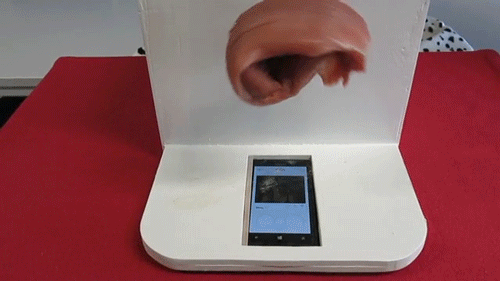Tender, a work by Cors Brinkman, Jeroen van Oorschot, Marcello Maureira, and Matei Szabo, takes literally the idea that the matchmaking app Tinder is a meat market and makes it visceral. The work replaces the human Tinder user with a spinning piece of raw meat, slapping a smartphone screen, forever swiping right. It seems to say: If you can’t stop swiping, if you are willing to match with anyone, then you are already a piece of meat yourself.
With Tinder, it seems that the only thing that matters to users is the expression of mutual interest in the moment; having more information ahead of time would do little to establish that mutual interest. The less we know, Tinder assumes, the more open we are to indulge our curiosity. All we need is a photo of the person and a “yes” or “no” answer to the question, “Do you want that?” Take this assumption to its logical conclusion, and we will experience complete openness, a willingness to try anything and a corresponding indifference to who we are supposed to be and who we have been. One finds happiness in not having to commit to anything because one is willing to commit to everything. Becoming meat, from this perspective, is not degradation so much as liberation from some of the ordinary constraints of the real world, the “meatspace.”
But more interesting to me than the meat in this work is the motor. It suggests that Tinder users aspire to become automatic in their swiping; what makes the app’s users undifferentiated—what reduces them to interchangeable pieces of meat—is their machine-like interaction with the interface. Becoming interchangeable is the price users must pay for a chance at not the pleasure of hooking up so much as the pleasure Tinder offers: a dissolution of the self in the midst of an otherwise intolerable system of exposure, objectification, and serial rejection. The fantasy of connection is an alibi for a deeper source of happiness, the surrender to a process that makes self-consciousness evaporate.
Within the app, each user is a singular face that, while superficial, still remains open-ended and can be invested imaginatively with all sorts of possibilities. The faces are not yet anonymous pieces of meat; they are fragments of fragile egos. It’s crucial that Tinder users forget that their own faces are in the app, circulating under such vulnerable conditions. Tinder guarantees that users will never encounter themselves that way, as a profile, but that alone isn’t sufficient protection. Further safety stems from automaticity, which narrows our focus to the point where we begin to disappear.
In Addiction by Design, the sociologist Natasha Dow Schüll describes how video-gambling machines offer players “a reliable mechanism for securing a zone of insulation from a ‘human world'”; they offer a “continuity” that “holds worldly contingencies in a kind of abeyance,” generating “a zone in which time, space, and social identity are suspended in the mechanical rhythm of a repeating process.” Something similar may occur with Tinder use. While using the app, a person is inserted into an automated workflow, performing one of a defined set of operations on the material in their queue. The Tinder user becomes a machine that needs flesh only insofar as the interface requires it, only in order to be detectable, to make the touchscreen respond, not some other fleshly human. On Tinder, users fulfill the dream not of finding a partner so much as becoming an engine, generative and propulsive, cranking through raw material without any responsibility for the final product.
Tinder doesn’t make the work of talking to other people easier; in fact, it intensifies that burden by accelerating the rate at which one makes matches. Instead, it offers the alternative of dwelling in the app and getting into the zone of swiping. By simplifying decisions, boiling them down to a simple question – “do you want that piece of meat?” — Tinder condenses user agency and executive function as they pertain to courtship, allowing users to exercise them quickly, in the mechanical rhythm adopted by video-machine gamblers. What happens after a match can be ignored in the pursuit of accumulating matches, each of which feels like an affirmation as long as it remains only a potential connection. Hooking up for real doesn’t matter. What matters is how fast your motor turns. Tinder automates the process of finding someone but not what do with them afterward.
But the pleasures of being efficient may ultimately outweigh the pleasures of human connection. The drive toward automation built into Tinder’s functionality draws on and reinforces the pleasures of sheer processing. Performing the limited operations within the app yields equally an unambiguous reward: some quantity of matches. The swipe, at its root, is a controlled gamble. Making matches are like hitting small jackpots that permit you to keep playing, with no pressure to figure out how to spend the winnings—to figure out who to meet in real life, or when, or why. The bliss of the gambler is merely to stay in the action.
The promise of a reasonable reward schedule, administered reliably by an ever-accessible app is more satisfying than the unpredictability of a real person, whose interest in you may be transient and inscrutable and who may themselves demand your constant engagement and require your vulnerability in wholly unpredictable and terrifying ways. Tinder guides us toward this radical self-involvement, in which statistics are sufficient to make us happy.
The idea that there really is a meat swiper, somewhere out there, should reassure us. It justifies the faith that there is a god in the machine, making sure everyone at some point gets their due dose of approval. Eventually, no matter who we are, something somewhere will swipe right on us.





